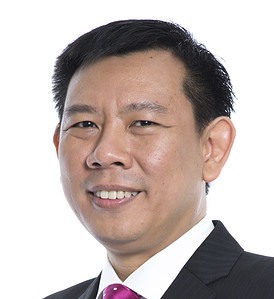ASEAN is poised to become world’s fourth largest economy by 2030. But getting there will require an unprecedented group effort.
More than 50 years after its founding, is the Association of Southeast Asian Nations—better known as ASEAN—set to emerge as the new EU?
The grouping of 10 Asia-Pacific states excluding China and Japan is on course to become the world’s fourth largest economic bloc by 2030, according to forecasts by a range of institutions, including the Asian Development Bank, the World Economic Forum, and ASEAN itself.
In an economic integration brief published a month prior to the Jakarta summit, ASEAN forecast that by 2030 its GDP would sit just behind those of the US, China, and India. The brief attributed this growth to the region’s youth: of a population of 670 million, 61% are currently under age 35 of whom half are expected to join the middle class by 2030.
Other factors informing such predictions include ASEAN’s position at the intersection of major trade routes—$3.4 trillion of global trade passes through the region annually—heavy inflows of foreign direct investment, both global and intra-regional; the rapid adoption of digital technologies, ensconced in the Consolidated Strategy on the Fourth Industrial Revolution for ASEAN, the blueprint the bloc adopted in 2021; and economic alignment of members with the goals of the Paris Climate Agreement and Sustainable Development Goals and the public-private partnerships that will flow from it. Add to this the increasing importance of Southeast Asia to international supply chains as de-globalization gathers momentum, and it’s not difficult to see how ASEAN could be propelled to the number-four spot.
Big Bloc Party
One key tool may be the Regional Comprehensive Economic Policy (RCEP), whcih is spearheaded by ASEAN, and is now the world’s biggest regional free trade agreement, covering more than 30% of both global GDP and the world’s population, and is expected to liberalize trade, investment, and services among its members, as well as regional supply and value chains. Significantly, China is a member of RCEP, and Chinese investment is expected to be a significant driver of growth in ASEAN. Beijing invests in the mining of minerals required for clean batteries, including bauxite, copper, and nickel. These could help it build regional supply chains in its bid to dominate the global electric vehicle market and as its companies shift production to ASEAN to address production capacity caps and emissions regulations at home.

Chinese companies are mining rare earth minerals in Myanmar, processing battery materials in Indonesia, building EV autos in Thailand and producing solar panels in Malaysia. Hence, ASEAN is actually helping China to dominate in these markets, opening a path for the people’s republic to control almost all of the world’s solar module supply by 2030 and 90% of its batteries, according to a report published this year by S&P Global.
“ASEAN will become a popular destination for foreign direct investment as multinationals rebalance supply chains to diversify geopolitical risk,” says Robert Ojeda-Sierra, director, Economics-Sovereigns at Fitch Ratings in London. “For instance, Indonesia, as well as Thailand and Vietnam, aims to become a key player in the electric vehicle supply chain by leveraging its large nickel reserves to attract investment.”
FDI and Green Goals
Challenges facing ASEAN, according to Ojeda-Sierra, include “the development gaps between and within members in terms of income, human capital, institutions, and infrastructure as well as disparities in good governance and the rule of law.”
Chinese companies are mining rare earth minerals in Myanmar, processing battery materials in Indonesia, building EV autos in Thailand and producing solar panels in Malaysia. Hence, ASEAN is actually helping China to dominate in these markets, opening a path for the people’s republic to control almost all of the world’s solar module supply by 2030 and 90% of its batteries, according to a report published this year by S&P Global.
“ASEAN will become a popular destination for foreign direct investment as multinationals rebalance supply chains to diversify geopolitical risk,” says Robert Ojeda-Sierra, director, Economics-Sovereigns at Fitch Ratings in London. “For instance, Indonesia, as well as Thailand and Vietnam, aims to become a key player in the electric vehicle supply chain by leveraging its large nickel reserves to attract investment.”
FDI and Green Goals
Challenges facing ASEAN, according to Ojeda-Sierra, include “the development gaps between and within members in terms of income, human capital, institutions, and infrastructure as well as disparities in good governance and the rule of law.”
ASEAN must do better at attracting capital as a bloc, says Eugene Wong, founder and CEO of the Sustainable Finance Institute Asia (SFIA) in Kuala Lumpur. “At the one end you have Singapore, a triple-A sovereign, and you have Laos and Indonesia at the other, and these exemplify the diverse credit propositions ensconced in the region.” Together, the member countries need to lower their cost of capital, he adds: “This will involve de-risking and the involvement of concessionary capital in public-private financing.”
Hitting the Paris agreement targets will also require a unified effort, says Wong. This means outlining collective aims across four environmental objectives and how ASEAN proposes to attract the capital needed to fund new, sustainable infrastructure. Key sectors include renewable energy, green buildings, sustainable transport, and water, waste and land management.
Several countries—Indonesia, the Philippines, Singapore, Thailand and Vietnam—have already developed or are developing their own taxonomies addressing these questions, to be aligned with ASEAN’s joint taxonomy. Version 2 published in March, categorizes economic activities as either “Green,” which contribute to or enable climate change mitigation, “Amber,” which contribute to decarbonization and “Red” which do not contribute to or enable climate change mitigation. Facilitating a gradual transition to a fully green, “Tier 1” regional economy is the Taxonomy’s aim and it has no explicit short to medium-term timeline—achieving net zero carbon emissions in ASEAN by 2050 is the ultimate long-term goal.
Sustainable Finance 2 aims to provide an “inclusive, overarching guide for the region” rooted in an orderly and just transition, says Noorrafidah Sulaiman, chair of the 40-member ASEAN Taxonomy Board (ATB), which is made up of the region’s central bank governors, capital markets and insurance regulators,and finance ministers and is tasked with hammering out a regional plan along the lines of the EU’s 2020 Green Taxonomy with which it is designed to be interoperable. Subsequent iterations of the ASEAN Taxonomy for Sustainable Finance will be produced as a result of the ATB’s ongoing dialogue.
In a region that relies heavily on fossil fuels and carbon-intensive activities that include green-tech mineral mining, agreeing on a single, similarly ambitious development plan will be a challenge. “The multi-level development banks are aiming at de-risking, to provide credit facilities with guarantees,” Wong points out, “and there is talk of providing downside currency risk mitigation, one of the core risks faced by overseas capital when investing in infrastructure projects in the region.”
“Many trillion dollars of savings are still not well matched with many trillion dollars of need,” says Jang Ping Thia, lead economist and manager of the Asian Infrastructure Investment Bank’s economics department in Beijing that focuses on sustainable project lending. “The gap needs to be closed from all sides of the equation.” The AIIB has approved around $45 billion of projects, and all AIIB projects since the middle of this year have been Paris-aligned, but it remains “to assist members and clients shift up another gear on climate financing and avoid slipping on net zero targets,” Thia notes.
Spotlight on Vietnam
To establish itself as the world’s fourth largest economic bloc, ASEAN will need GDP gains in all its member countries, but the odds are on Vietnam—which booked the region’s strongest GDP growth last year, 8.02%—to deliver the most powerful, transformative contribution.

Still, “Vietnam must be more than ‘China+1’ or a Disneyesque ‘Last Dragon,’” says Will Ross, head of marketing at London-listed Dragon Capital in Ho Chi Minh City, a $4 billion Vietnam-focused venture capital fund. “There are two enablers of non-linear growth, and they form a virtuous circle. First is the need to increase its manufacturing capacity value chain through research and development and to capture margin by moving to direct-to-consumer from being an original equipment maker” a manufacturer whose products are sold by another company under that company’s name. Second is for Vietnam to “increase the addressable market for its products and services in ASEAN and further afield. Given its commitment to net-zero by 2050, Vietnam may prove that the path through the middle-income trap does not have to be through ever dirtier industry.” In other words, going green while still building up a strong market for its goods within ASEAN itself.
But that underscores the potential holes in ASEAN’s script. Case in point is the stratospheric rise of Indonesia’s nickel industry, which is poised to produce 60% of the world’s nickel by 2030. President Joko Widodo has imposed a ban on nickel ore export to encourage the downstreaming of the product to high-value domestic industries including smelting. Nickel is a key component in electric vehicle batteries but nickel mining is heavily carbon intensive.
Brunei Darussalam is another ASEAN outlier in the decarbonization story. Second only to Singapore in per capita GDP within the bloc, the International Monetary Fund has estimated that 70% of the sultanate’s national income derives from hydrocarbon exports. That sits uneasily with the aim of excluding fossil fuels from the final, enforceable ASEAN taxonomy, wherein Brunei’s “amber” activities must “sunset” to render its economy “fully green.” And Brunei is not alone; many countries bound by the Paris Agreement face the same challenges.




